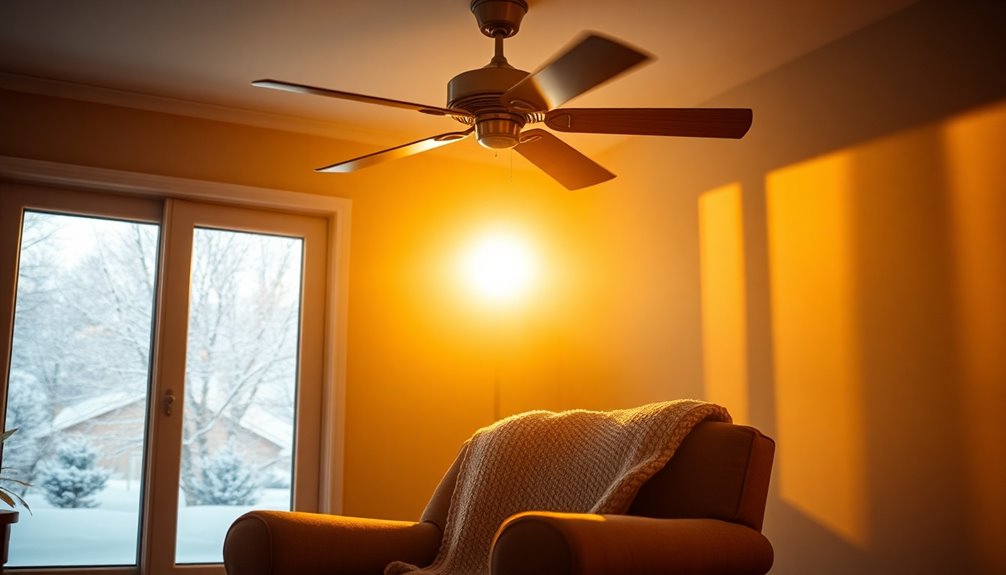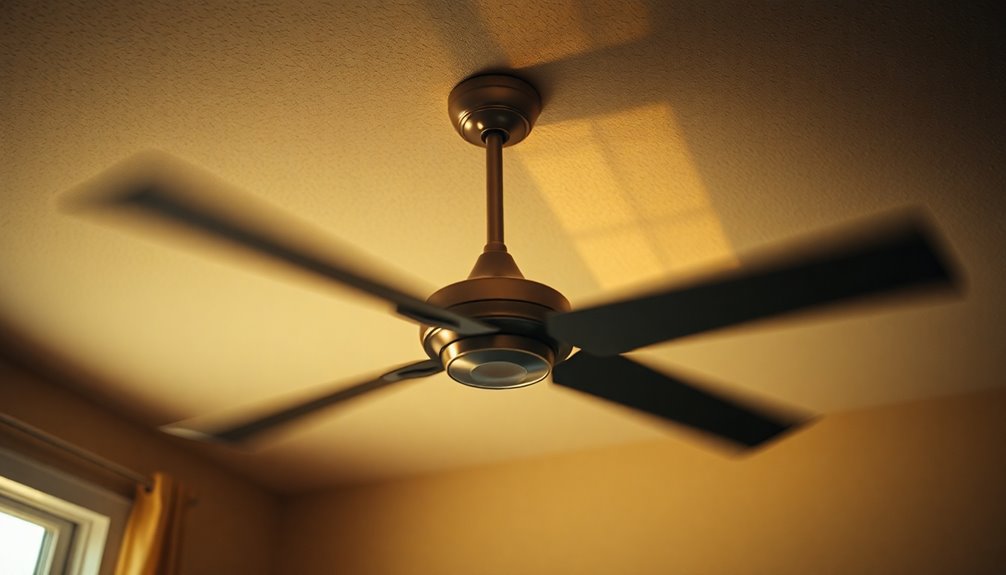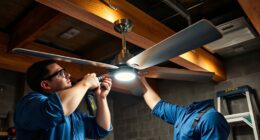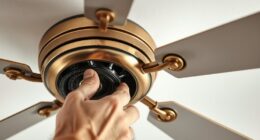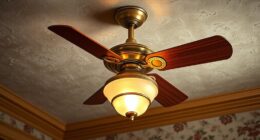To find the right size ceiling fan, start by measuring your room. For spaces up to 100 square feet, contemplate 29-36 inch fans. If your room is 144 to 225 square feet, a 42-inch fan will do the trick. For medium rooms, you'll need a fan measuring 36-50 inches, while larger spaces might require fans up to 71 inches. Don't forget about airflow efficiency—larger fans usually offer better circulation. It's also essential to take into account fan height and appropriate downrod length for ideal performance. Stick around to discover more tips on choosing and installing the perfect fan for your space!
Key Takeaways
- Measure your room's dimensions to calculate the square footage for determining the appropriate fan size.
- For rooms 144-225 sq ft, choose a fan with a 42-inch blade span; larger rooms require 50-71 inch fans.
- Ensure the fan height is 8 feet from the floor for optimal airflow; use downrods for ceilings over 9 feet.
- Check the CFM (cubic feet per minute) ratings; higher ratings ensure better airflow for your room size.
- Consider the room's shape; for irregular spaces, calculate fan size based on each section's dimensions.
Measuring Your Room Size

When you're choosing the right ceiling fan, measuring your room size is essential. To get the square footage, simply multiply the room length by the room width. For example, a 12 x 15-foot room equals 180 square feet.
If you've got an L-shaped room, don't worry! Just divide it into rectangles, calculate the square footage for each section, and sum them up for accurate measurements.
Using a tape measure helps guarantee those measurements are precise. Knowing your room's square footage directly influences the ceiling fan size you'll need for ideal cooling and airflow efficiency. A fan that's too small won't circulate air effectively, while one that's too large can create uncomfortable drafts.
Additionally, consider your ceiling height; this can also impact the fan size. Higher ceilings may require fans with longer downrods to guarantee proper airflow.
Understanding Ceiling Fan Sizes

After measuring your room size, the next step is understanding ceiling fan sizes to make certain you choose the right one for your space. Ceiling fan sizing is primarily determined by the blade span, which should correspond to your room's square footage for ideal airflow.
For instance, a 42-inch fan works well in rooms between 144-225 square feet. If your room is up to 100 square feet, a fan size of 29-36 inches is ideal. For medium rooms up to 400 square feet, look for fans between 36-50 inches. Great rooms exceeding 400 square feet will require a fan size of 50-71 inches.
When ceiling fan buying, pay attention to CFM ratings, as they indicate airflow capacity. A fan with a higher CFM rating will provide better air circulation, so make certain it matches your room size for efficiency.
For irregularly shaped rooms, consider dividing the space into sections and choosing a fan size based on each section's dimensions.
Finally, always measure your ceiling heights, as this will determine if you need a downrod to achieve the ideal height for your fan's performance.
Ideal Ceiling Fan Height

The ideal height for ceiling fans is around 8 feet from the floor to the blades, guaranteeing excellent airflow and comfort in your space. Installing your ceiling fan at this height promotes peak airflow, making your room feel more comfortable.
It's essential to maintain at least 7 feet of clearance from the floor to avoid safety hazards and guarantee proper air circulation.
If your ceiling heights are lower than 8 feet, think about using low-profile or flush mount fans. These types provide adequate clearance while still allowing for efficient airflow.
Standard-mount fans require a clearance of 12-14 inches from the ceiling for peak performance, whereas flush-mount fans need just 6-10 inches.
For rooms with ceilings higher than 9 feet, you'll need to use downrods for effective air circulation. This adjustment will help lower the fan to a more suitable height, enhancing its performance.
During fan installation, always remember to take these height guidelines into account to maximize comfort and safety. By choosing the right fan height, you'll create a more enjoyable environment in your home.
Calculating Downrod Length

Installing a ceiling fan at the right height is only part of the equation; calculating the correct downrod length is equally important for ideal air circulation. If your ceiling height exceeds 9 feet, you'll need a downrod to position the fan correctly.
Typically, the height of the fan housing measures between 8 to 12 inches, so be sure to factor this in when determining the downrod length. For a 10-foot ceiling, using a 12-inch downrod places the fan at the recommended 8 feet above the floor, guaranteeing both safety and effective airflow efficiency.
It's vital to select downrods based on ceiling height charts, which link specific ceiling heights with corresponding downrod lengths. This guarantees your ceiling fans achieve the best airflow possible.
Maintain at least 7 feet of clearance above the floor to enhance safety and comfort. An appropriately sized downrod not only aids in airflow efficiency but also complements the overall ceiling fan size.
Additional Considerations for Fans

When you're choosing a ceiling fan, don't forget to think about light kit options and whether your ceiling can support the fan's weight.
Light kits can add height, so measure carefully to avoid clearance issues.
Also, guarantee your ceiling's structure is strong enough to hold the fan and any additional features you might want.
Light Kit Considerations
Choosing the right light kit for your ceiling fan can considerably enhance your space's overall functionality and aesthetic. When selecting a light kit, keep in mind the compatibility with your existing fan model, as not all fans accommodate every type.
Additionally, take into account how the light kit may affect your ceiling fan height. You'll want to measure the combined height to guarantee adequate clearance from the ceiling.
Here are some factors to think about with light kits:
- Integrated Lighting: Opt for seamless designs that blend well with your fan.
- Energy-Efficient Bulbs: Choose LED or CFL options to lower electricity costs while providing sufficient illumination.
- Adjustable Brightness: Look for kits that allow you to set the mood with varying light levels.
- Color Temperature Settings: Enhance ambiance by selecting the right color warmth for your space.
- Overall Height: Always factor in how the light kit will impact the overall height of the fan.
Ceiling Support Requirements
After selecting the perfect light kit for your ceiling fan, it's important to confirm your ceiling can adequately support the fan's weight and installation requirements.
Most fans require a sturdy electrical box rated for fan support, typically made of metal. If your fan weighs more than 35 pounds, you might need additional bracing or support beams in your ceiling.
Clearance is essential, too. Make sure there's at least 8 inches between the fan blades and the ceiling, and verify the fan is at least 7 feet above the floor for safety.
If you have an angled ceiling, you'll need an angled-ceiling adapter to keep the fan positioned correctly, especially for slopes between 34 to 56 degrees.
Finally, check for any obstructions like light fixtures, beams, or ductwork that could interfere with the fan's operation. These obstructions can affect performance and pose safety risks.
Ceiling Fan Airflow and Efficiency

Understanding ceiling fan airflow and efficiency is vital for creating a comfortable living space. The Cubic Feet per Minute (CFM) rating plays an important role in determining how well a fan can circulate air. Higher CFM ratings generally indicate better airflow efficiency, especially in larger spaces.
To make sure you choose the right ceiling fan size, consider these factors:
- CFM ratings: Small rooms (up to 100 sq ft) need 1,000-2,000 CFM, while large rooms (over 400 sq ft) should have 8,000 CFM or more.
- Blade span: Larger ceiling fans move more air quietly, enhancing comfort levels.
- Cooling effect: Fans can lower perceived temperatures by 6-8 degrees.
- Energy savings: Opt for energy-efficient ceiling fans to reduce energy costs and consumption.
- Air circulation: Effective airflow improves your home's overall comfort level.
Types of Ceiling Fan Motors

When it comes to ceiling fans, the type of motor you choose can profoundly influence both performance and energy efficiency. You typically have two options: AC motors and DC motors.
AC motors are the most common in households, providing economical operation with three speed options. They're generally easier to install and have lower upfront costs.
However, if you're looking for something more energy-efficient, DC motors are the way to go. These motors can reduce energy consumption by up to 70% compared to traditional AC motors.
DC motors also offer a greater range of speeds, allowing for customized airflow that suits your preferences. Plus, they operate much quieter, enhancing your comfort. Regular maintenance can also help prevent dangerous situations that may arise from using ceiling fans improperly.
Keep in mind that while AC motors have a simpler design, DC motors may require an adapter for installation, depending on your home's electrical system.
Ultimately, the choice of ceiling fan motors can greatly impact the operational efficiency and noise level of your fan.
Installation Tips for Ceiling Fans

Before you start installing your ceiling fan, it's essential to prepare properly by gathering the right tools and materials.
Keep safety in mind during installation, ensuring the fan is at the correct height and securely fastened.
After installation, don't forget to maintain your fan regularly to keep it running smoothly and efficiently. Additionally, consider the average cost of installation to ensure your budget aligns with your ceiling fan project.
Preinstallation Preparation Steps
Installing a ceiling fan requires careful preparation to guarantee a smooth and safe process. Before diving into the installation, there are several preinstallation steps you should take:
- Confirm you have a suitable electrical box that meets local building codes; metal boxes are typically required for ceiling fans.
- Measure your ceiling height to determine if you need a flush mount or downrod mount; standard mounts need 12-14 inches of clearance from the ceiling to the fan.
- Always turn off power at the circuit breaker to avoid electrical hazards during the installation.
- Follow the manufacturer's instruction manual closely for proper installation steps and safety precautions.
- If you're unsure about your installation skills or the electrical setup, consider consulting a qualified electrician.
Taking these steps won't only help you avoid common pitfalls but also confirm that your ceiling fan operates efficiently and safely.
Proper preinstallation preparation sets the foundation for a successful installation, allowing you to enjoy your new ceiling fan without worry.
Safety Precautions During Installation
Safety is paramount during the installation of a ceiling fan to prevent accidents and guarantee a successful setup. Before you start, always turn off power at the circuit breaker to avoid electrical shock. This simple step is vital for your safety.
Next, use a sturdy ladder placed on a flat surface to reach the ceiling securely. Verify that the electrical box is rated to support the fan's weight; an inadequate box can lead to serious safety hazards.
As you handle the fan and tools, wear safety goggles and work gloves to protect yourself from debris and sharp edges. This precaution helps you avoid injuries while you work.
It's also essential to follow the manufacturer's manual closely. This document contains key safety guidelines and specifications tailored to your specific fan model. Adhering to these instructions will guarantee a smooth installation process and enhance your safety.
Postinstallation Maintenance Guidelines
Once your ceiling fan is installed and running smoothly, maintaining its performance is key to enjoying its benefits over time.
Regular maintenance will guarantee your fan operates efficiently and enhances airflow in your space. Here are some essential guidelines to follow:
- Clean the blades regularly to prevent dust buildup that can impede airflow and decrease efficiency.
- Inspect the mounting hardware every few months to ensure everything remains secure and tight, avoiding potential safety hazards.
- Lubricate the fan motor as recommended by the manufacturer, which helps maintain smooth operation and prolongs the fan's lifespan.
- Replace any worn or damaged pull chains and remote controls promptly, ensuring ease of use and functionality.
- Schedule a professional inspection if your fan is used extensively, helping identify potential issues before they escalate.
Maintenance and Care for Fans

Maintaining your ceiling fan is vital for guaranteeing its best performance and longevity. Regular maintenance keeps your fan operating efficiently and quietly. Here are some key steps to follow:
| Task | Frequency |
|---|---|
| Clean ceiling fan blades | Monthly |
| Inspect fan motor | Every 3 months |
| Lubricate fan motor | Annually |
To start, clean the ceiling fan blades with a damp cloth or microfiber duster to remove dust and debris that can hinder airflow. Next, inspect the fan motor and electrical components for any signs of wear or damage. Don't forget to check for any loose screws and tighten them every few months to maintain a stable operation.
If your fan operates noisily or wobbles, it's important to address these issues. Balancing the blades can enhance performance; use a blade balancing kit if necessary. Finally, remember to lubricate the fan motor according to the manufacturer's instructions, usually once a year. By following these maintenance tips, you'll guarantee your ceiling fan runs smoothly and efficiently for years to come.
Frequently Asked Questions
Is a 52 Inch Fan Too Big for a 12X12 Room?
A 52-inch fan can feel too big for a 12×12 room.
While it might provide ample airflow, it could create a drafty atmosphere that makes you uncomfortable.
You'll want to balance aesthetics and efficiency; a fan that's too large can disrupt the room's vibe.
For ideal comfort, consider a 44-inch fan, which is generally more suitable for smaller spaces and will keep the airflow pleasant without overwhelming the room.
What Size Room for a 52 Inch Ceiling Fan?
Imagine walking into a room where the air feels fresh and inviting—that's the power of a well-chosen ceiling fan.
A 52-inch fan works best in spaces between 225 and 400 square feet, making it perfect for your living room or bedroom.
Just guarantee your ceiling's at least 8 feet high for ideal airflow.
This fan size balances comfort and style, enhancing your room's ambiance while keeping you cool on those warm days.
Is a 42-Inch Fan Big Enough for a Bedroom?
Yes, a 42-inch fan is big enough for a bedroom, especially if it's between 144 to 225 square feet.
It'll provide adequate airflow, keeping you comfortable throughout the day and night.
If your bedroom is smaller than 144 square feet, you might want to contemplate a 36-inch fan instead.
Just remember to check your ceiling height to guarantee your fan's installed safely and effectively for ideal cooling.
What Size Room Do I Need for a 60 Inch Ceiling Fan?
Choosing the right space for a 60-inch ceiling fan is like picking the perfect frame for a masterpiece; it enhances the overall experience.
You'll want a room that exceeds 400 square feet for ideal airflow. This size fan's designed to cool open-concept living areas, large bedrooms, or great rooms effectively.
Confirm your ceiling height is at least 8 feet for safety and efficiency, allowing the fan to circulate air freely throughout the space.
Conclusion
In choosing the right ceiling fan, you're not just picking a decoration—you're creating a breeze that dances like the winds of a summer's day. By measuring your room, understanding fan sizes, and considering airflow, you can guarantee your space remains comfortable and inviting. Just like a well-orchestrated symphony, each element plays a vital role in the overall harmony of your home. So go ahead, let your fan be the gentle whisper that elevates your living experience.

